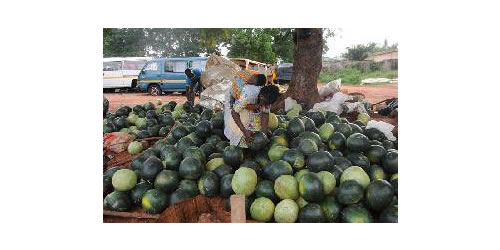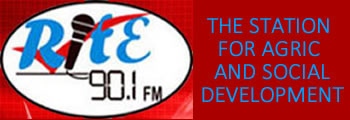Watermelon glut – Good for consumers, bad for the farmers

It is 11 a.m. on a cloudy day in June when the sun and cloud are in a turf war for the sky but on his farm at Ada, Joshua Kutsoafo, is fighting a battle of survival with a watermelon glut that has crashed prices.
The 35-year-old farmer is among hundreds of others who hope to cash in on last year’s windfall for farmers who cultivated the ovoid fruit, but are now left counting either their loses or meagre profits.
“This is the worst season for us ever since I started cultivating watermelon 15 years ago. Everybody is growing watermelon,” he said with his hands folded across his chest and his eyes glued to the fruits piling before him as the harvest on his family’s farm continues.
Such has been the bumper harvest that some traders on the Sege-Sogakope stretch of the Accra-Aflao road abandoned their produce, leaving it to rot because of an excess supply and few demand.
In the midst of plenty, the people benefiting most are middlemen from big commercial centres including Accra, Tema and Aflao who are milking the farmers and making profit in the cities.
Across Mr Kutsoafo’s farm, Mr Tettey Dayitey, another farmer and his wife are busily marking the fruit before carting it to the roadside.
This is where the grading begins. The huge green ones attract the premium price but the deep green ones, even when they are small are expensive because they are high in demand.
The biggest fruit, which last year was between GH¢ 12 to GH¢15 last year even on the farm is now between GH¢ 3 to GH¢ 7.
On the farms, the fruit, depending on its size and colour are between 10 pesewas and GH¢ 6. By the roadside, it is going for between GH¢1 and GH¢ 8.
Why bumper harvest?
According to the farmers and the acting district director of Agriculture of the Ada East District, many factors accounted for the excessive supply of the produce.
A favourable weather pattern, just enough rainfall and the decision of urban dwellers to invest in vast acres of the fruit because of last year’s windfall from watermelons have been some of the reasons attributed to the glut.
“The thing with watermelons is if you make some money in one year, then everybody wants to join the party and plant watermelons.
“Some of these people who are government workers from the cities don’t have the connections to sell them. They flood the market once the watermelons get ripe and then we all lose. This is what has crashed the market,” Mr Kutsoafo said.
But the District Director of Agriculture of Ada East District, Mr Mahamadu Seidu, said the early rains and the fact that even farmers who previously farmed vegetables went into watermelon were contributing factors to the bumper harvest.
“It gives the farmers quick money. It takes less than three months for the watermelon to mature. So farms that otherwise would have cultivated other crops and vegetables also cultivated watermelon, leading to so much of the crop being produced.”
Over the years, farmers in the two districts use watermelon as an avenue to make enough money in preparation for the season when they cultivate vegetables including tomatoes, onion and staples including cassava and maize.
The investment
A drought resistant crop, watermelon needs just a small amount of rain and an early rain in April opened the door for the farmers who saw an opportunity to make quick money but the end result has not been favourable.
To get a good yield, the farmers invest at least GH¢200 per acre in land preparation, fertiliser, spraying and weeding.
Post-harvest loss
According to the Ministry of Environment, Science, Technology and Innovation figures, Ghana loses between 20 and 50 per cent of all vegetables, fruits, cereals, roots and tubers produced each year, while it struggles to achieve food security and eradicate hunger.
The losses are as a result of inadequate storage facilities, poor road infrastructure and the lack of ready market for most agricultural produce.
Post harvest losses are as old as agriculture in Ghana. The numbers do not favour farmers whose best bet is selling to the consuming public with little to feed non-existing industries. Watermelon is no exception.
That is the concern of Octogenarian, Mr Israel Kutsoafo, who said “we are tired, we produce so much, they have consistently promised us a factory to process but nothing has come out of it. It is a waste of time discussing how much we lose every year because it won’t amount to anything.”
But Mr Seidu said the district had used the Women in Agriculture Development (WIAD) unit under the Ministry of Food and Agriculture to train at least 100 farmers in Ada East and Ada West districts on fruit juice processing.
However, the training sessions ended almost two years ago because the official in charge went on retirement.
Elsewhere, watermelon is processed into jam, juice, facial toners and toffees but in Ghana, beyond being eaten raw, it can only become manure.
Preventing the glut
To cut down their losses, the farmers have taken a decision to harvest just enough for the market and not clutter their roadside market with too much of the produce.
“If we don’t put so much on the market, the prices would begin to go up. That is the only way to recoup our investment, “Mr Daniel Adinortey, who said he had invested close to GH¢1800 but was yet to break even after selling three quarters of the produce on his six acre farm.
That decision appears to work, as consumers and middlemen alike are beginning to complain about the increasing price.
“Last week, I bought a sizeable watermelon for GH¢2 but today, they want GH¢ 4 for the same size. The thing is all over the place, I don’t know why they are now asking so much for it. Just look around it is rotten along the road.”
Madam Mary Nyantakyi, a trader at the Agbogbloshie Market also had similar complaints.
“It is not as though we are making much. When you bring it to the market and the prices shoot up like that, when people have heard that it is in abundance, they don’t want to pay much for it. In the end, we are the losers because it would just rot. ”
“Some watermelons we bought between 50 pesewas and GH¢ 3 have suddenly jumped to between GH¢1 to 8. How do I sell these and recoup my transport and make profit?” she asked.
To reduce a recurrence of the glut, Mr Seidu said the directorate had decided to zone the district and educate the farmers not to cultivate watermelon at the same time because it is not profitable during a bumper harvest.
“As we speak, tomatoes are expensive because a lot of the farmers, who would have cultivated it, went into watermelon production. This experience will help us to put our message across,” he added.
Nutritional value
Glut or not, watermelon is nutritious and needed by the body. It is mostly water — about 92 per cent — but experts say the fruit is soaked with nutrients. Each juicy bite has significant levels of vitamins A, B6 and C, lots of lycopene, antioxidants and amino acids and a modest amount of potassium.
Mrs Alice Koryo-Dabrah ,a lecturer of the Department of Nutrition and Dietetics of the University of Health and Allied Sciences said the antioxidants in watermelon “ are very good in preventing cancers, “adding that the fruit was also good for those interested in losing weight as it was low in calories.
“Every part of the watermelon is very important. It is not just the pink part that we eat but also the whitish part. The seed contains iron, zinc, protein and fibre”, she said.
That aside, watermelon contains compounds that enhance muscle movement, reduces muscle pain, enhance blood flow and also good for the heart.
Source: Seth J. Bokpe



